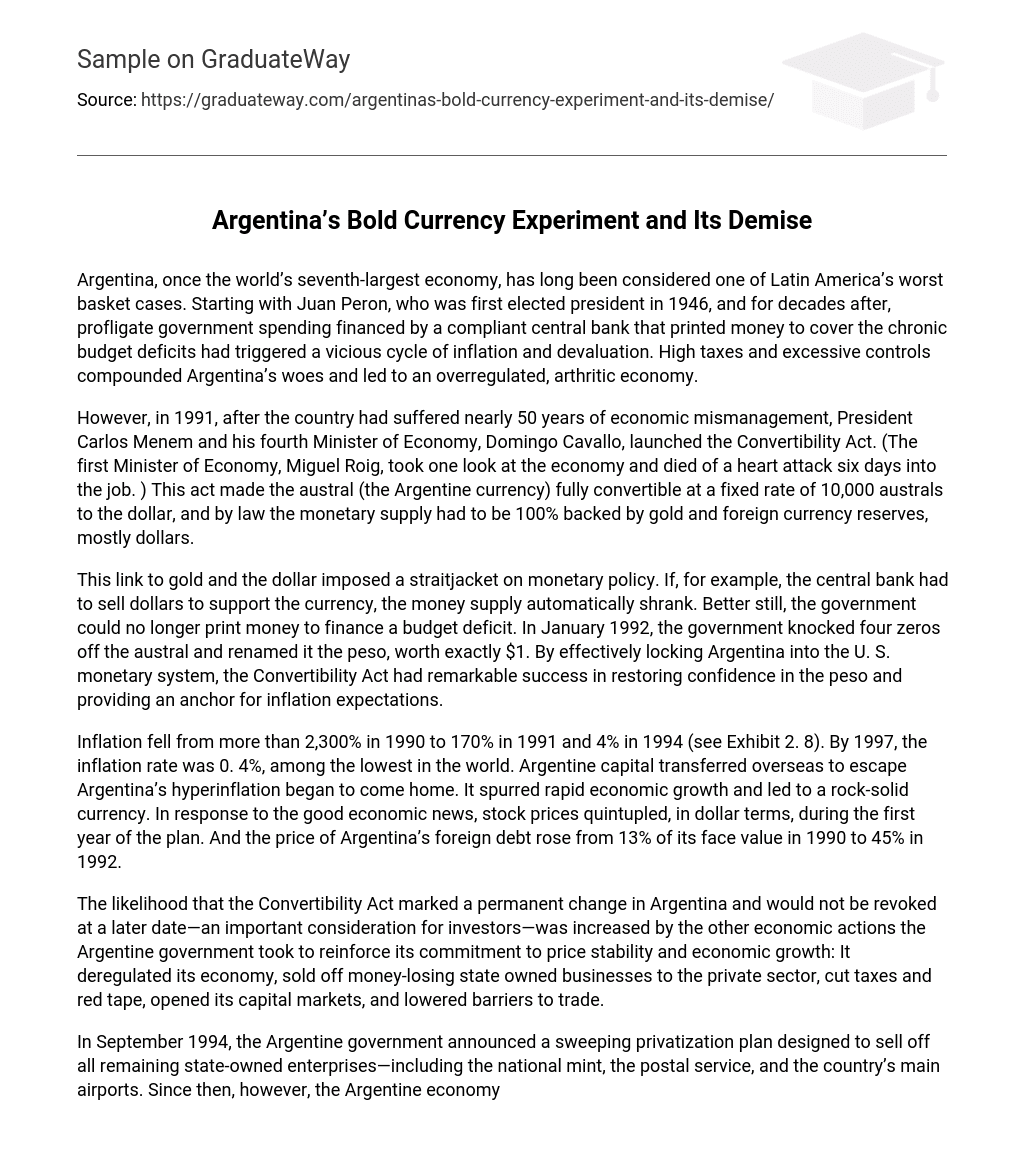Argentina, once the world’s seventh-largest economy, has long been considered one of Latin America’s worst basket cases. Starting with Juan Peron, who was first elected president in 1946, and for decades after, profligate government spending financed by a compliant central bank that printed money to cover the chronic budget deficits had triggered a vicious cycle of inflation and devaluation. High taxes and excessive controls compounded Argentina’s woes and led to an overregulated, arthritic economy.
However, in 1991, after the country had suffered nearly 50 years of economic mismanagement, President Carlos Menem and his fourth Minister of Economy, Domingo Cavallo, launched the Convertibility Act. (The first Minister of Economy, Miguel Roig, took one look at the economy and died of a heart attack six days into the job. ) This act made the austral (the Argentine currency) fully convertible at a fixed rate of 10,000 australs to the dollar, and by law the monetary supply had to be 100% backed by gold and foreign currency reserves, mostly dollars.
This link to gold and the dollar imposed a straitjacket on monetary policy. If, for example, the central bank had to sell dollars to support the currency, the money supply automatically shrank. Better still, the government could no longer print money to finance a budget deficit. In January 1992, the government knocked four zeros off the austral and renamed it the peso, worth exactly $1. By effectively locking Argentina into the U. S. monetary system, the Convertibility Act had remarkable success in restoring confidence in the peso and providing an anchor for inflation expectations.
Inflation fell from more than 2,300% in 1990 to 170% in 1991 and 4% in 1994 (see Exhibit 2. 8). By 1997, the inflation rate was 0. 4%, among the lowest in the world. Argentine capital transferred overseas to escape Argentina’s hyperinflation began to come home. It spurred rapid economic growth and led to a rock-solid currency. In response to the good economic news, stock prices quintupled, in dollar terms, during the first year of the plan. And the price of Argentina’s foreign debt rose from 13% of its face value in 1990 to 45% in 1992.
The likelihood that the Convertibility Act marked a permanent change in Argentina and would not be revoked at a later date—an important consideration for investors—was increased by the other economic actions the Argentine government took to reinforce its commitment to price stability and economic growth: It deregulated its economy, sold off money-losing state owned businesses to the private sector, cut taxes and red tape, opened its capital markets, and lowered barriers to trade.
In September 1994, the Argentine government announced a sweeping privatization plan designed to sell off all remaining state-owned enterprises—including the national mint, the postal service, and the country’s main airports. Since then, however, the Argentine economy suffered from a series of external shocks and internal problems. External shocks included falling prices for its agricultural commodities, the Mexican peso crisis in late 1994, the Asian currency crisis of 1997, and the Russian and Brazilian financial crises of 1998–1999.
The financial shocks led investors to reassess the risk of emerging markets and to withdraw their capital from Argentina as well as the countries in crisis. The evaluation of the Brazilian real in early 1999—which increased the cost of Argentine goods in Brazil and reduced the cost of Brazilian goods to Argentines—hurt Argentina because of the strong trade ties between the two countries. Similarly, the strong appreciation of the dollar in the late 1990s, made Argentina’s products less competitive, both at home and abroad, against those of its trading partners whose currencies were not tied to the dollar.
Internal problems revolved around rigid labor laws that make it costly to lay off Argentine workers and excessive spending by the Argentine government. In a decade that saw GDP rise 50%, public spending rose 90%. Initially, the growth in government spending was funded by privatization proceeds. When privatization proceeds ran out, the government turned to tax increases and heavy borrowing. The result was massive fiscal deficits, a rising debt burden, high unemployment, economic stagnation, capital flights, and a restive population.
On June 14, 2001, Domingo Cavallo, the treasury secretary for a new Argentine president, announced a dramatic change in policy to stimulate Argentina’s slumping economy, then in its fourth year of recession. Henceforth, the peso exchange rate for exporters and importers would be an average of a dollar and a euro, that is, With the euro then trading at about $0. 85, exporters would now receive around 8% more pesos for the dollars they exchanged and importers would have to pay around 8% more for the dollars they bought.
Financial markets panicked, fearing that this change was but a prelude to abandonment of the currency board. In response, Mr. Cavallo said that his new policy just amounted to a subsidy for exporters and a surcharge on imports and not an attempt to devalue the peso. Over the next six months, Argentina’s bold currency experiment unraveled amid political and economic chaos brought about by the failure of Argentine politicians to rein in spending and to reform the country’s labor laws.
During the two-week period ending January 1, 2002, Argentina had five different presidents and suspended payments on its $132 billion in public debt, the largest sovereign debt default in history. On January 6, 2002, President Eduardo Duhalde announced that he would end Argentina’s decade-long currency board system. The collapse of the currency board had devastating consequences. Over the next week, the Argentine peso plunged by 50% against the dollar.
By year’s end, the peso had depreciated 70%, the government had imposed a draconian banking freeze that sparked violent rioting, and a severe economic contraction took the Argentine economy back to 1993 levels. In effect, forced to choose between the economic liberalization and fiscal discipline that was necessary to save its currency board and the failed economic policies of Peronism, Argentina ultimately chose the latter and wound up with a disaster.





